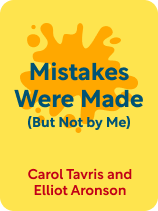

This article is an excerpt from the Shortform book guide to "Mistakes Were Made (But Not by Me)" by Carol Tavris and Elliot Aronson. Shortform has the world's best summaries and analyses of books you should be reading.
Like this article? Sign up for a free trial here.
What is the book Mistakes Were Made about? What are the main takeaways of the book?
In Mistakes Were Made (But Not by Me), Carol Tavris and Elliot Aronson argue that we self-justify to relieve cognitive dissonance. This is the discomfort triggered when we do things that don’t align with other beliefs, actions, and values.
Read below for a brief overview of the Mistakes Were Made book.
Mistakes Were Made (But Not by Me) by Carol Tavris and Elliot Aronson
Why do people justify their questionable actions and big mistakes? In their book Mistakes Were Made (But Not by Me), social psychologists Carol Tavris and Elliot Aronson argue that we do so to relieve cognitive dissonance. We experience cognitive dissonance when two of our thoughts, values, or behaviors contradict each other: for instance, when we think we’re good at something but make a huge mistake when actually doing it. This state threatens the consistency of our worldview and sense of self, creating mild to intense psychological discomfort.
(Shortform note: Tavris and Aronson discuss cognitive dissonance as a negative experience we should try to avoid, but dissonance can be applied therapeutically to help people create healthier behavioral patterns. For example, a person with a strong phobia usually knows their level of fear is irrational, which inspires cognitive dissonance. To reduce mental discomfort, they might avoid the thing they’re afraid of. However, the dissonance from the conflict between their rational beliefs and irrational phobia can also show them that their fear is unfounded, motivating them to overcome it. When someone confronts their fear instead of avoiding it and nothing bad happens, they’re often able to let go of their irrational fears in favor of their new, healthier behavior.)
The authors examine several unconscious processes we use to reduce the discomfort of cognitive dissonance, including self-justification, confirmation bias, and memory distortion. These biases help us to justify poor decisions that create dissonance, and by learning about them, you can begin to recognize your own biases, challenge them, and take accountability for your actions.
(Shortform note: The authors explore several cognitive biases in this book. However, they don’t clearly define what a cognitive bias is on its most basic level. Cognitive biases are automatic assumptions we make about situations, ourselves, and other people. Often, they’re wrong, leading to unfounded conclusions and poorly informed actions. Though they often get us into trouble, they’re likely so prevalent because they conserve energy. Our brains are confronted with a constant flow of information and choices, leading to overwhelm and fatigue. Biases can help us save energy otherwise spent processing this information by prompting snap judgments about people, places, and things—even if they’re often inaccurate.)
Tavris and Aronson are both seasoned psychologists, writers, and educators. Tavris has also written Anger, which deconstructs misconceptions about this common emotion, and The Mismeasure of Woman, which challenges the problematic practice of treating men as the “normal” standard in everything from history to medicine. Aronson has written several other books, including The Social Animal, his introduction to social psychology, and Nobody Left to Hate, an exploration of the damaging social culture in American schools in the wake of the 1999 Columbine High School shooting. He’s won several awards for his scientific research, writing, and teaching.
In this book, the authors define cognitive dissonance, self-justification, confirmation bias, and memory distortion and discuss how they work in tandem to help us rationalize our choices. In addition, they explore:
- How we justify choices that undermine the qualities most important to our sense of self
- How patterns of self-justification can cause our beliefs to diverge sharply from other people’s—even people we once agreed with
- How we can break free from the cycle of self-justification and take accountability for our actions
What Is Cognitive Dissonance?
Cognitive dissonance is an uncomfortable psychological state that occurs when we have two contradictory beliefs, attitudes, or ideas. According to the authors, we also experience cognitive dissonance when our actions conflict with our beliefs or our sense of self. For example, if you find factory farming practices objectionable, you’ll likely experience some cognitive dissonance if you still eat meat.
Cognitive dissonance causes minor to extreme psychological discomfort because it threatens our belief in an ordered, meaningful existence. We’re constantly trying to make sense of the world around us, and we want to believe that our actions and choices are consistent and rational. When we act or think in a way that contradicts our beliefs, we can no longer claim consistency or rationality. To relieve the discomfort caused by cognitive dissonance, we seek ways to eliminate the contradictions. Often, this takes the form of self-justification, confirmation bias, and memory distortion.
Self-Justification and Protecting Our Sense of Self
Now that we’ve explored the basic psychological processes behind our need to soothe cognitive dissonance, the authors zoom in on the specific patterns of one of these processes: self-justification. In this section, they discuss how the authors claim we justify bad decisions to preserve three commonly held positive self-perceptions: 1) that we’re rational; 2) that we’re competent; and 3) that we’re righteous.
How Patterns of Self-Justification Lead to Polarization
Now, the authors dive into another impact of this process: polarization, or extreme divergence in once similar people’s beliefs and perceptions of the world. According to the authors, two people who start off sharing the same beliefs, abilities, values, and psychological health can become vastly different over time and lose empathy for each other through a pattern of self-justification.
How to Break the Cycle of Self-Justification
People will go to great lengths to preserve their self-perception as rational, competent, and righteous individuals. These patterns of self-justification can drive us apart, leaving once similar people unable to understand each other.
Though self-justification is an inherent part of our psychological makeup, Tavris and Aronson assert that we don’t have to let it control us. In this final section, the authors discuss how you can start taking more accountability for your actions and break the cycle of self-justification through two steps:
- Accept discomfort and acknowledge your mistakes
- Understand your personal bias

———End of Preview———
Like what you just read? Read the rest of the world's best book summary and analysis of Carol Tavris and Elliot Aronson's "Mistakes Were Made (But Not by Me)" at Shortform.
Here's what you'll find in our full Mistakes Were Made (But Not by Me) summary:
- Why we feel discomfort when we act in a way that doesn't align with our values
- How patterns of self-justification can cause our beliefs to diverge sharply from other people’s
- How we can break the cycle of self-justification and hold ourselves accountable






